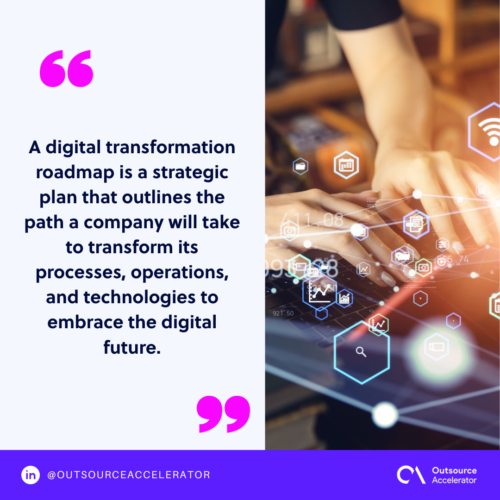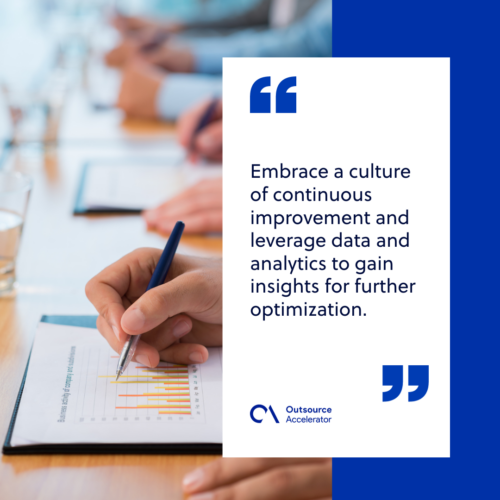How to build a digital transformation roadmap

With more operations getting fast-paced, having manual processes won’t always suffice in giving the best service to customers.
Organizations must embrace digital transformation to stay competitive and meet customers’ changing needs. However, embarking on a transformation journey can be a daunting task.
With various moving parts and complexities involved, having a well-crafted digital transformation roadmap is essential to provide a clear direction and milestones throughout your digital journey.
Learn the steps of building an effective digital transformation roadmap in this article.
What is a digital transformation roadmap?
A digital transformation roadmap is a strategic plan that outlines the path a company will take to transform its processes, operations, and technologies to embrace the digital future.
This roadmap provides a holistic view of the transformation journey. It includes objectives, priorities, and estimated timelines for each phase.
It also taps into four transformation areas in an organization, namely:
- Customer experience
- Data and analytics
- Business transformation
- Digital operations
A well-designed roadmap ensures all stakeholders are aligned, resources are utilized efficiently, and risks are properly managed.

Why you need a digital transformation roadmap
A digital transformation roadmap is a must-have for successful transformation. Let’s explore the reasons why your organization needs a well-defined roadmap:
Strategic direction. A roadmap provides a clear vision and direction for your digital transformation journey. It helps align all stakeholders towards a common goal, from top management to front-line employees.
Risk management. Digital transformation comes with inherent risks. Having an effective roadmap helps identify potential risks and challenges so you can develop mitigation strategies and contingency plans.
Efficient resource allocation. A roadmap helps allocate resources effectively by outlining priorities and timelines. It enables you to identify and prioritize initiatives based on their impact and resource requirements.
Measurable goals. An efficient digital transformation roadmap lets you set clear objectives and KPIs for each transformation stage. This helps monitor progress and provides motivation and accountability for stakeholders.
Adaptability. Lastly, a well-designed roadmap allows you to adjust and pivot as new technologies emerge or business priorities change.
Steps to building a digital transformation roadmap
Building a digital transformation roadmap requires careful planning, research, and execution. Let’s explore the key steps involved:
Researching the landscape
The first step in building a digital transformation roadmap is conducting thorough research. This involves understanding your current business state, identifying gaps and opportunities, and benchmarking against industry best practices.
Dive deep into market trends, customer needs, and emerging technologies to gain insights to inform your transformation strategy.
Defining the digital transformation strategy
With research insights in hand, it’s time to define your digital transformation strategy. Identify the areas of your business that require transformation. Is it improving customer experience or enhancing employee productivity?
Clearly define your objectives, goals, and KPIs for each area. This will provide a roadmap framework and help you prioritize initiatives effectively.
Exploring technology options
Evaluate your existing technology stack and determine where upgrades or new solutions are needed.
Research and explore different technology options that align with your transformation goals. Consider factors like scalability, integration capabilities, and overall cost-effectiveness.
Choose technologies that enable your organization to innovate, streamline processes, and enhance customer experiences.
Project launch
With your strategy and technology options in place, it’s time to launch your digital transformation projects. Start with smaller, manageable initiatives that offer quick wins and demonstrate the value of digital transformation.
Prioritize initiatives based on their potential impact, feasibility, and resource requirements. Engage key stakeholders from different departments to ensure buy-in, collaboration, and ownership.
Executing the transition
Managing the transition from legacy systems to new digital solutions is crucial. Provide training and support to empower employees to embrace and adopt new technologies effectively.
Communication is key during this phase. Regularly update stakeholders on the progress, address concerns or challenges, and celebrate successes along the way.
Monitor and evaluate the processes, making necessary adjustments to optimize efficiency and effectiveness.
Updated business operations
You’ll witness updated and improved business operations as your digital transformation initiatives mature. Continuously evaluate the impact of your transformation efforts and make necessary adjustments to stay on track.
Embrace a culture of continuous improvement and leverage data and analytics to gain insights for further optimization.
Be proactive in identifying new opportunities for innovation and ensure ongoing engagement and education of employees.
Deploying a digital transformation roadmap
Digital transformation is a continuous journey. It requires a clear roadmap, commitment, collaboration, and perseverance.
Deploying a digital transformation roadmap is not a one-time event either. Regularly review and update your roadmap to align with changing market dynamics and emerging trends.
By following the steps outlined in this article and continually refining your approach, you will build a digital transformation roadmap that drives sustained growth. This also ensures your organization’s success in the ever-evolving digital landscape.
Embrace innovation and stay ahead by continuously exploring new ideas and opportunities. Engage with industry experts and thought leaders to gain insights, validate your approach, and fine-tune your roadmap.








 Independent
Independent




